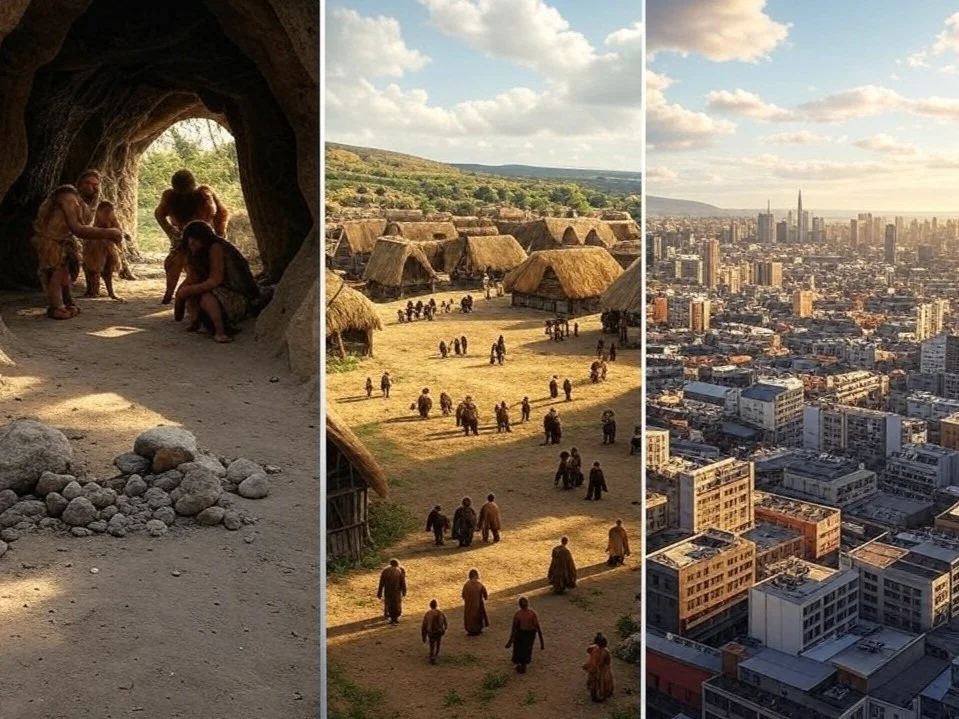The transition from nomadic hunter-gatherer lifestyles to settled urban centers marks one of the most significant developments in human history. This evolution, spanning thousands of years, reflects profound changes in social organization, technology, and environmental interaction. Archaeological evidence from early villages and cities, such as Çatalhöyük and Jericho, provides valuable insights into this transformative journey.
Hunter-Gatherer Lifestyles
For the vast majority of human history, our ancestors lived as hunter-gatherers, relying on the natural environment for sustenance. These nomadic groups moved seasonally to follow game and gather wild plants. Their shelters were temporary, often consisting of caves, simple huts, or lean-tos. The lifestyle was characterized by small, egalitarian groups with a deep understanding of their environment.
The Neolithic Revolution
The shift from hunting and gathering to agriculture, known as the Neolithic Revolution, began around 10,000 BCE. This period saw the domestication of plants and animals, which allowed for more stable and predictable food sources. The ability to produce surplus food was a key factor in the development of permanent settlements.
Early Villages
Jericho: Located in the West Bank, Jericho is one of the oldest known continuously inhabited settlements, dating back to around 9000 BCE. Archaeological evidence reveals that early inhabitants built mud-brick houses and a massive stone wall, possibly for protection. The presence of a tower within the wall suggests a level of social organization and communal effort.
Çatalhöyük: Situated in modern-day Turkey, Çatalhöyük flourished around 7500–5700 BCE. This large Neolithic settlement is notable for its densely packed mud-brick houses, which were accessed through roofs rather than doors. The settlement lacked streets, indicating a unique social structure. Artifacts found at Çatalhöyük, including wall paintings, figurines, and tools, provide insights into the daily lives, religious practices, and artistic expressions of its inhabitants.
The Rise of Urban Centers
As agricultural practices became more efficient, populations grew, leading to the development of larger and more complex settlements. These early urban centers were characterized by increased social stratification, specialized labor, and monumental architecture.
Key Characteristics of Early Cities
Social Stratification: The surplus of food allowed some individuals to engage in non-agricultural activities, leading to the emergence of specialized roles such as artisans, traders, and rulers. This differentiation in roles contributed to social hierarchies.
Monumental Architecture: Early cities often featured large-scale structures, such as temples, palaces, and city walls, which served religious, administrative, and defensive purposes. These constructions required coordinated labor and advanced engineering skills.
Trade and Economy: The concentration of people in urban centers facilitated trade and the exchange of goods. Early cities became hubs for economic activity, connecting different regions and cultures.
Archaeological Evidence of Early Cities
Uruk: Located in Mesopotamia (modern-day Iraq), Uruk is considered one of the world's first true cities, flourishing around 4000–3100 BCE. It was a major center of trade, culture, and political power. The city is famous for its monumental architecture, including the ziggurat of Anu and the Eanna temple complex. The invention of writing, particularly cuneiform script, during this period marks a significant advancement in record-keeping and administration.
Mohenjo-Daro: Part of the Indus Valley Civilization (circa 2600–1900 BCE), Mohenjo-Daro in present-day Pakistan is renowned for its advanced urban planning. The city featured a grid layout, sophisticated drainage systems, and standardized brick sizes. Public buildings, such as the Great Bath, suggest a high level of communal organization and possibly religious significance.
Teotihuacan: In Mesoamerica, Teotihuacan (circa 100 BCE–550 CE) was one of the largest cities of the ancient world. The city's layout, centered around the Avenue of the Dead, includes monumental structures like the Pyramid of the Sun and the Pyramid of the Moon. Teotihuacan's influence extended across the region, and its decline remains a subject of scholarly debate.
The Significance of Urbanization
The development of cities represented a major shift in human society. Urban centers became the focal points of political power, economic activity, and cultural innovation. They facilitated the exchange of ideas, technologies, and goods, driving progress and complexity in human civilization.
However, urbanization also brought challenges, such as increased social inequality, environmental degradation, and the spread of diseases. The study of early cities helps us understand the origins of these issues and the ways ancient societies addressed them.
Conclusion
The evolution of human settlements from caves to cities is a testament to human ingenuity and adaptability. The transition from hunter-gatherer lifestyles to organized urban centers was driven by advancements in agriculture, technology, and social organization. Archaeological sites like Çatalhöyük, Jericho, Uruk, Mohenjo-Daro, and Teotihuacan provide a window into this transformative period, revealing the complexities and achievements of early human societies. As we continue to explore these ancient settlements, we gain a deeper appreciation for the foundations of modern civilization and the enduring legacy of our ancestors.







